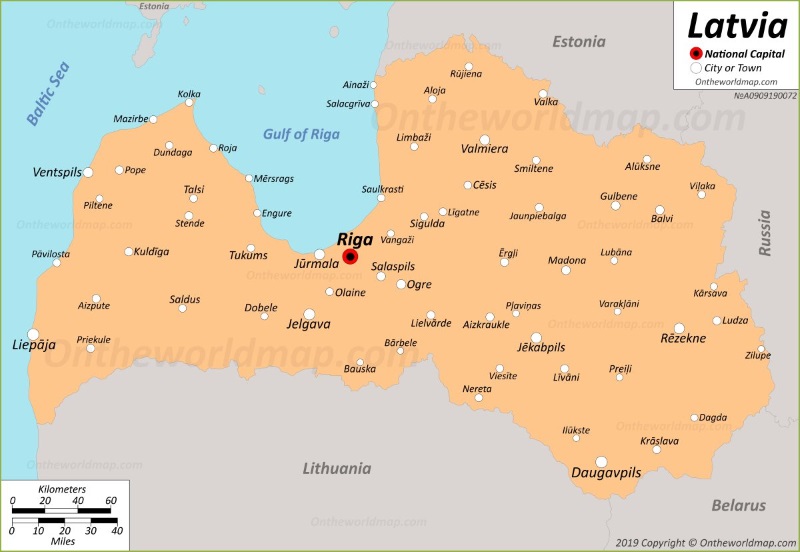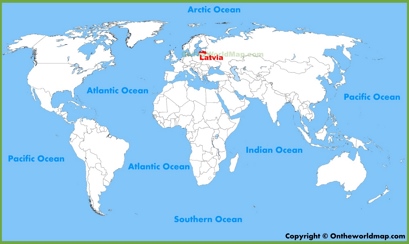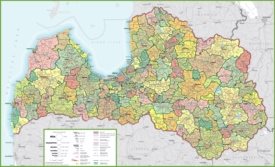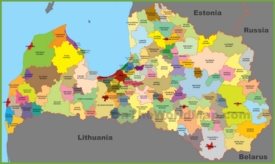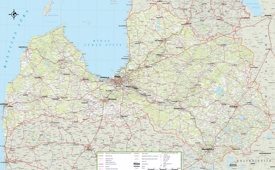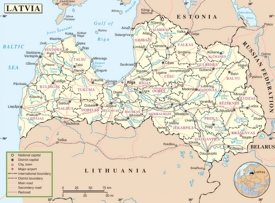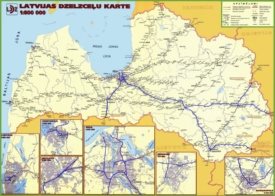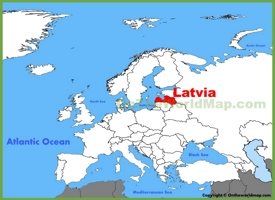Latvia Map
Description:
This map shows governmental boundaries of countries; capital city, major cities and towns in Latvia.
Size: 1200x828px / 118 Kb
Author: Ontheworldmap.com
You may download, print or use the above map for educational, personal and non-commercial purposes. Attribution is required. For any website, blog, scientific research or e-book, you must place a hyperlink (to this page) with an attribution next to the image used.
Online Map of Latvia
Detailed Maps of Latvia
About Latvia
Latvia is a Baltic state in Northern Europe, located on the eastern shore of the Baltic Sea. It borders Estonia to the north, Lithuania to the south, Russia to the east, and Belarus to the southeast.
Riga, the capital and largest city, serves as the political, economic and cultural center of the country. The city, known for its Art Nouveau architecture and medieval Old Town, plays an important role in Latvia's economic activity.
Other major cities include Daugavpils, Liepaja and Jelgava. Daugavpils, the second largest city, functions as an important industrial center. Liepāja, located on the Baltic Sea coast, is of strategic importance due to its ice-free port, while Jelgava serves as an educational and administrative center.
Latvia's economy, characterized by a well-developed industry and service sector, transitioned from a centrally planned system to a market economy after regaining independence in 1991. Key industries include wood processing, agriculture, engineering and electronics. Latvia also has a growing information technology sector, which contributes significantly to the country's GDP. A member of the European Union since 2004, the country adopted the euro in 2014, further integrating its economy into the European market.
Latvia boasts a high Human Development Index, reflecting its concern for education, health and quality of life. The country maintains a parliamentary democracy with a unicameral legislature and a multi-party system.
Latvia's strategic position and its membership in the European Union and NATO emphasize its geopolitical importance in the region. The country continues to focus on economic development, innovation and regional cooperation to strengthen its position in the world.
The Facts:
Capital: Riga.
Area: 24,938 sq mi (64,589 sq km).
Population: ~ 1,850,000.
Largest cities: Riga, Daugavpils, Liepāja, Jelgava, Jūrmala, Ventspils, Rēzekne, Valmiera, Jēkabpils, Ogre, Salaspils.
Official language: Latvian.
Currency: Euro (€) (EUR).
Geography of Latvia
Latvia, located in Northern Europe, has a diverse geography characterized by low-lying plains and hills. The country is divided into four main regions: Vidzeme in the northeast, Latgale in the southeast, Kurzeme in the west, and Zemgale in the south. Vidzeme is home to the highest point, Gaisinkalns (312 meters).
Latvia has a temperate climate with maritime and continental influence, which causes mild summers and cold winters. The Baltic Sea moderates the coastal climate, while inland areas experience more pronounced seasonal fluctuations. Forests cover about 54% of the territory, which contributes to Latvia's rich biodiversity. Numerous rivers, including the Daugava, Gauja and Venta, crisscross the country, providing vital water resources and supporting diverse ecosystems. Wetlands and lakes further enhance Latvia's geographical diversity.
Brief History of Latvia
Latvia's history reflects a complex interplay of regional influences and foreign domination. Indigenous Baltic tribes inhabited the region until the arrival of the German Crusaders in the 12th century, which marked the beginning of Christianization and integration into European medieval structures. Over the centuries, Latvia was under the control of various powers, including the Polish-Lithuanian Commonwealth, Sweden and Russia.
Latvia declared independence in 1918 after World War I, but lost it in 1940 due to Soviet occupation. During World War II, the country was occupied by Nazi Germany, after which Soviet control resumed until 1991. Latvia regained independence after the collapse of the Soviet Union and subsequently sought integration into Western institutions, joining the European Union and NATO in 2004.
Maps of Latvia
Cities of Latvia

